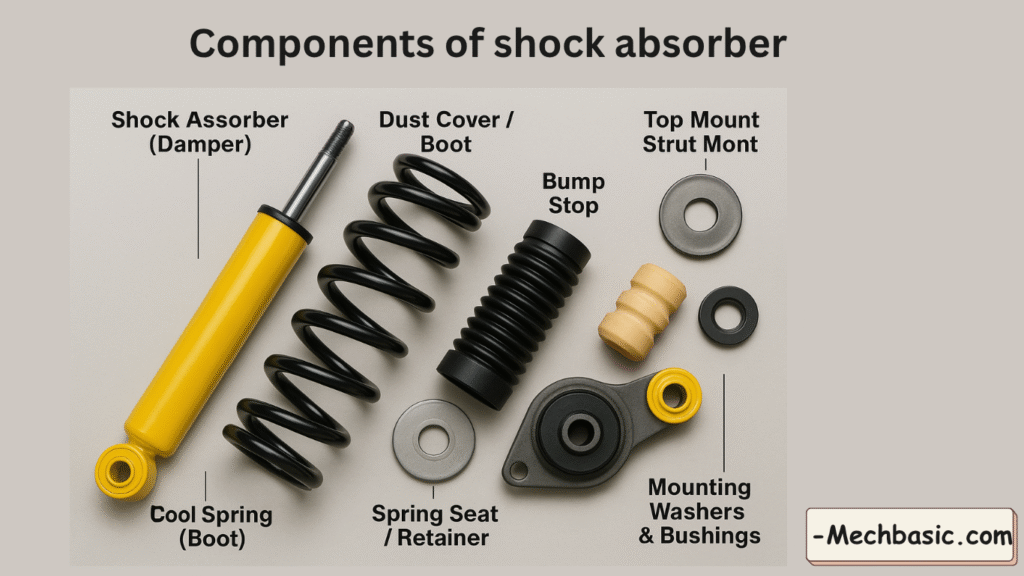A shock absorber is a key component of a vehicle’s suspension system that controls the movement of the springs and suspension. It ensures that the tires stay in contact with the road by dampening the vibrations and oscillations caused when the vehicle drives over bumps, potholes, or rough surfaces.
In this article:
Definition:
A shock absorber is a hydraulic or gas-filled device that resists the motion of the vehicle’s suspension, helping provide ride comfort, stability, and control.
Why does a car need shock absorbers?
1. Control Suspension Movement
- Without shock absorbers, the springs would bounce uncontrollably after every bump.
- Shocks dampen (slow down and reduce) the oscillations of the suspension, keeping the vehicle stable.
2. Maintain Tire Contact with the Road
- Shock absorbers help keep the tires in firm contact with the ground, especially over uneven surfaces.
- This ensures better grip, braking, and steering.
3. Improve Ride Comfort
- Shocks absorb vibrations from the road (potholes, speed bumps, etc.), minimizing what passengers feel inside the cabin.
4. Enhance Safety
- By reducing body roll, pitch, and dive, shocks help the car stay balanced during turns, acceleration, and braking.
- Prevents excessive swaying, nose-diving, or bouncing which could lead to loss of control.
5. Reduce Wear on Other Components
- Properly functioning shock absorbers reduce stress on tires, suspension joints, and chassis components.
- Leads to longer lifespan for tires and better overall reliability.
Main Components of a Shock Absorber:

- Shock Absorber (Damper)
- The central hydraulic or gas-filled cylinder that controls suspension movement.
- Damps the oscillations from the spring by converting kinetic energy into heat.
- Coil Spring (Boot)
- Often referred to as the suspension spring.
- Absorbs road shocks and supports the vehicle’s weight.
- Works in tandem with the damper to maintain ride height and comfort.
- Dust Cover / Boot
- A flexible sleeve that protects the piston rod from dirt, water, and debris.
- Prevents seal damage and prolongs shock absorber life.
- Spring Seat / Retainer
- A metal or rubber platform where the coil spring sits.
- Ensures proper alignment and cushions the spring against the shock body.
- Bump Stop
- A rubber or polyurethane component that prevents the shock from fully compressing.
- Acts as a safety buffer to avoid metal-to-metal contact under hard bumps.
- Top Mount / Strut Mount
- Connects the shock absorber to the vehicle’s body or frame.
- Often includes a bearing if part of a front suspension strut to allow steering rotation.
- Mounting Washers & Bushings
- Rubber or polyurethane bushings and steel washers that reduce vibrations and absorb shock.
- Provide a secure, cushioned connection between the shock and the vehicle.
| Component | Function |
|---|---|
| Shock Absorber | Controls spring movement and damps suspension oscillation |
| Coil Spring | Supports weight and absorbs energy from road impact |
| Dust Boot | Shields piston rod from dirt and debris |
| Spring Seat | Holds the spring in place securely |
| Bump Stop | Prevents bottoming out of the shock |
| Strut Mount | Connects to vehicle body, may aid steering |
| Washers & Bushings | Isolate vibrations and reduce noise |
How Does a Shock Absorber Work?
Step-by-Step Working:
Here’s the step-by-step working of shock absorber in car.
1. Wheel Hits a Bump
- The spring compresses to absorb the shock.
2. Spring Rebounds
- Without control, the spring would continue to bounce.
3. Shock Absorber Resists Motion
- The shock absorber slows down this motion using hydraulic damping:
- Inside the shock, a piston moves through oil or gas.
- As the piston moves, it forces fluid through small orifices/valves, creating resistance.
4. Dampens Oscillations
- Converts the kinetic energy from movement into heat, which is dissipated through the shock body.
- Result: a smoother, more stable ride.
Types of Shock Absorbers:
| Type | Description |
|---|---|
| Twin-Tube | Most common; uses two cylinders (inner and outer) |
| Mono-Tube | One cylinder; better heat dissipation; performance-oriented |
| Gas-Charged | Filled with nitrogen gas to reduce aeration and improve response |
| Adjustable | Can be manually or electronically tuned for ride stiffness |
| Electronic/Dynamic | Computer-controlled; changes stiffness in real time (used in luxury/performance cars) |
Also Read : Types of shock absorber in detail.
Purpose of Shock Absorbers:
- Control spring movement
- Improve ride comfort
- Enhance vehicle handling and safety
- Prevent excessive tire wear
- Reduce body roll, bounce, and sway
Signs of a Worn or Failing Shock Absorber
- Bumpy or unstable ride
- Nose diving during braking
- Uneven tire wear
- Leaking fluid from the shock body
- Vehicle sways or leans in turns
- Takes longer to stop
Related articles:
- What is a suspension system in automobile?
- Types of suspension system in cars.
- How to know if suspension system is bad?
- How to repair car suspension system?
Other courses:



